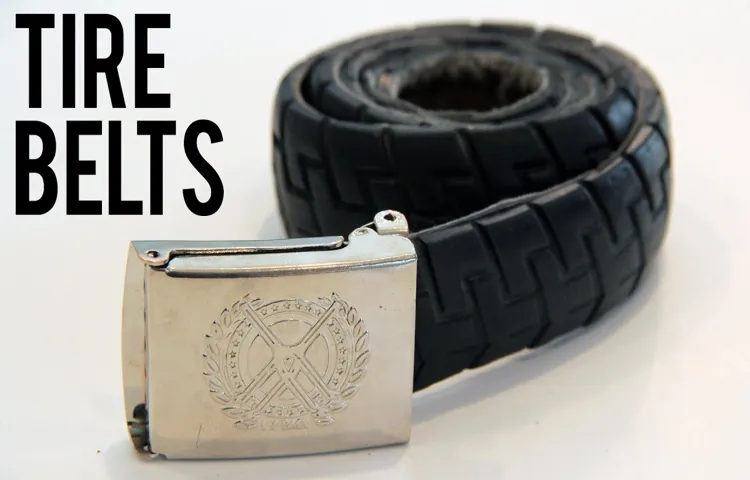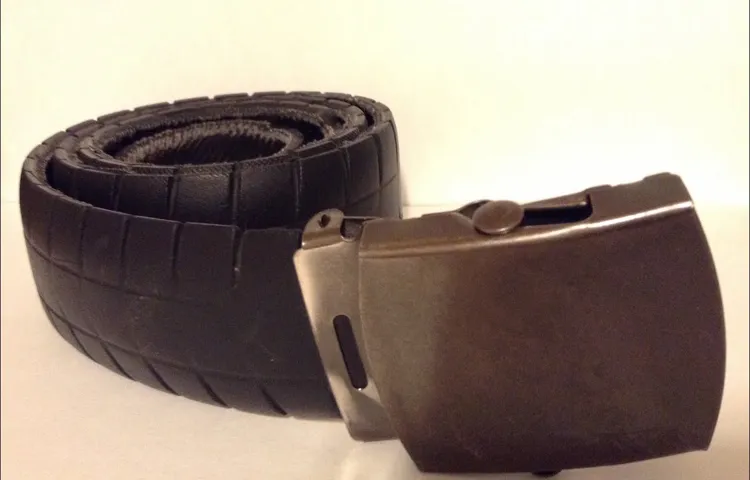Have you ever wondered what the tire belt in your car tires is? It may not be something you think about often, but the tire belt is a crucial part of your tire’s structure. It plays a significant role in maintaining the shape, stability, and overall performance of your tire. In this blog post, we’ll dive into what a tire belt is, why it matters, and how it affects your driving experience.
So fasten your seatbelt and let’s hit the road!
Table of Contents
Definition of a Tire Belt
A tire belt refers to the reinforcing component of a tire that sits beneath the tread and runs around the circumference of the tire. It is made up of a strong, flexible material, usually polyester or steel, and helps to add stability and strength to the tire. The tire belt serves as a foundation for the tire’s tread and helps to prevent punctures or cuts that can damage the integrity of the tire.
In some cases, a tire may have multiple layers of belts, which adds to its durability and overall strength. Tire belts are an essential component of any tire, and without them, a tire would be much more susceptible to damage on the road. So, the next time you’re driving and your tires are keeping you safe, remember that it’s the tire belt that is helping to keep you on the road!
Types of Tire Belts: Steel and Polyester
A tire belt is a crucial component of a tire that enhances its durability and stability. It is located inside the rubber tire and a layer of steel or polyester cords that wrap around the circumference of the tire to reinforce it. The two most common types of tire belts are steel and polyester.
Steel belts are durable, providing superior stability and strength, especially on high-speed roads, while also improving resistance to punctures. On the other hand, polyester belts are lightweight, providing improved fuel efficiency and ride comfort. In general, tire manufacturers tend to use a combination of both steel and polyester belts to optimize strength and comfort.
For drivers, it’s essential to know about the types of tire belts to determine the best tire for their driving needs. So, before purchasing a tire, always check its specifications, especially the type and number of belts, to ensure it meets your demands.

Functions of a Tire Belt: Support and Traction
A tire belt is a crucial component of a tire that plays a vital role in providing support and traction. It is a layer of reinforcement made of steel or other materials that sits between the tread and the carcass of the tire. The primary function of a tire belt is to provide structural support to the tire and prevent it from deforming under the weight of the vehicle.
It helps to maintain the shape of the tire, ensuring uniform contact between the tire and the road surface. Another essential function of a tire belt is to provide traction. Its sturdy construction allows it to maintain constant contact with the road, even when driving on uneven or slippery surfaces.
This constant contact helps to improve both the acceleration and braking capabilities of the vehicle, providing a safer driving experience. In addition, the tread pattern on the tire belt is designed to provide additional grip, particularly in wet or snowy conditions. In summary, a tire belt is a crucial component of a tire that provides both support and traction.
Its construction is such that it can withstand the weight of the vehicle while maintaining a constant grip with the road. This provides the driver with better handling and control, particularly in slippery conditions. It is a small but essential component that contributes significantly to the overall performance and safety of the tire.
Impact of a Worn Out Tire Belt
Tire belts are crucial components of a vehicle’s tire construction that help maintain its structural integrity and ensure optimal performance. Essentially, a tire belt is a reinforced layer of rubber that sits beneath the tread and works to provide stability, support, and protection against wear and tear. When a tire belt starts to wear out, it can have a significant impact on the tire’s overall performance, leading to a range of issues such as decreased traction, sidewall deformation, and increased risk of punctures.
This is why it’s important to regularly check your tire’s condition and pay attention to any signs of wear and tear on the tire belt, such as cracks or bulges. If you notice any signs of a worn out tire belt, it’s important to get it replaced as soon as possible to ensure optimal performance and safety on the road. So, keep an eye on your tire belts and drive safe!
Risk of a Blowout and Tire Failure
When it comes to driving, ensuring that your tires are in good condition is crucial for your safety. One of the risks of a worn out tire belt is the possibility of a blowout or tire failure. This occurs when the tire belt, which is the steel belt that reinforces the tire, starts to wear out due to age, overuse, or poor maintenance.
As a result, the tire can become unstable, making it more susceptible to punctures, cracks, or even an explosion. This not only puts you and your passengers in danger but also other drivers on the road. It is important to regularly inspect your tires for any signs of wear and tear, and to replace them as needed.
Don’t let a worn-out tire belt put you at risk – invest in new tires and stay safe on the road.
Poor Vehicle Handling and Reduced Fuel Efficiency
The tire belt is an essential component in ensuring optimal vehicle handling and fuel efficiency. However, as with any component in a vehicle, the tire belt will inevitably wear out over time. When the tire belt wears out, it can cause a host of issues that will negatively impact your driving experience.
Some of these issues include poor vehicle handling, reduced fuel efficiency, and an increased risk of a blowout. This is because a worn tire belt will cause your vehicle’s wheels to wobble, which will make it harder to control your car when driving. Additionally, a worn tire belt will increase the rolling resistance of your tires, which will reduce your vehicle’s fuel efficiency.
While it may be tempting to delay replacing a worn tire belt, doing so will only lead to more significant issues down the road. Therefore, it’s essential to replace your tire belt promptly to ensure optimal vehicle performance and safety.
Uneven Wear and Tear on Tires
If you’re experiencing uneven wear and tear on your tires, it could be due to a worn out tire belt. The tire belt is the part of the tire that helps to maintain its shape and stability. Over time, the tire belt can become damaged or worn, causing the tire to become uneven and resulting in rough handling and poor performance.
A tire with a worn out belt can be dangerous as it may blow out while driving, causing a serious accident. Therefore, it’s important to have your tires checked regularly and replace them as soon as any problems are detected. Don’t take chances with your safety and the safety of others on the road.
Remember, a little prevention can go a long way in ensuring a smooth ride!
How to Check and Replace a Tire Belt
A tire belt is an important component of the modern tire. It is a layer of reinforced steel or synthetic material that sits between the rubber tread and the tire carcass. The tire belt is responsible for maintaining the shape of the tire, providing extra strength and resistance to punctures.
Over time, the tire belt can become damaged or worn out, leading to problems such as leaks, blowouts, or reduced handling performance. To check the condition of a tire belt, you should inspect the tire for any signs of cracking, bulging, or uneven wear. If you notice any of these issues, it’s time to replace the tire.
Replacing a tire belt is not an easy task and requires special tools and expertise. It is best to take your vehicle to a professional mechanic who can inspect and replace the tire belt for you. By maintaining the quality of your tire belts, you can ensure better handling, safety, and longevity of your tires.
Visual Inspection and Tread Wear Indicators
When it comes to tire maintenance, one crucial aspect that often goes overlooked is checking the tire belt. The tire belt is responsible for keeping the tire tread stable and connected to the rest of the tire. To check the tire belt, start by visually inspecting the tire for any signs of wear or damage.
Look for cracks, bulges, or any inconsistencies in the tread pattern. If you see any of these signs, it’s time to replace the tire. You can also use tread wear indicators located on the tire to gauge its condition.
These are small rubber bars that go across the tread and only become visible once the tread has worn down to a certain level. If the bars are visible, it’s time to replace the tire. Ignoring issues with the tire belt can lead to reduced handling and performance on the road, so it’s important to keep an eye on it and replace it as needed.
By performing regular visual inspections and using tread wear indicators, you can ensure your tires are in top condition and ready to handle any driving conditions.
When and How Often to Replace a Tire Belt
Tire belt Your tire belt may not be top-of-mind when it comes to vehicle maintenance, but it plays an important role in keeping your tires rolling smoothly. The belt is made of layers of steel, nylon, and rubber that wrap around the tire’s core and help it maintain its shape. But like any component in your car, it can wear out over time and cause issues.
So, how do you know when to replace it? The best way to check is to visually inspect the belt for any signs of damage, such as cracks or missing pieces. You can also run your hand over the tread and feel for any bumps or bulges that could indicate a problem. If you do need to replace the tire belt, it’s recommended to do so every 40,000 to 60,000 miles, depending on your driving habits and the type of tire you have.
Keep in mind that a worn or damaged tire belt can lead to poor handling, reduced gas mileage, and even a blowout on the road. So, don’t neglect this important component of your tires and keep an eye out for signs of wear.
Conclusion: Maintaining Your Tire Belt for Optimal Safety and Performance
In summary, a tire belt is the unsung hero in keeping our vehicles rolling smoothly on the road. It’s the reinforced layer of rubber and fabric that provides stability and strength, preventing the tire from bulging or deforming, and ultimately ensuring a safe and comfortable ride. In other words, the tire belt is like the backbone of a tire, holding everything together and allowing it to keep its shape, even when it’s under pressure.
So, the next time you’re cruising down the highway, give a nod of appreciation to your trusty tire belt – it’s the strong and silent type that deserves a little recognition.”
FAQs
What is a tire belt?
A tire belt is a layer of steel or other synthetic material located beneath the tire’s tread that helps it maintain shape and stability.
What is the purpose of a tire belt?
The purpose of a tire belt is to provide added strength, stability, and durability to the tire, helping it resist punctures, vibrations, and wear.
How does a tire belt affect performance?
A tire belt can improve a tire’s handling and grip on the road, as well as reduce rolling resistance, which can lead to better fuel economy.
Can a tire belt be replaced if it’s damaged?
A tire belt cannot be replaced separately from the tire, but if a tire belt is damaged, the entire tire may need to be replaced to ensure safety and performance.
Do all tires have a tire belt?
Not all tires have a tire belt, but most modern passenger and commercial vehicle tires do have at least one layer of reinforcement material, such as steel, nylon, or polyester.
How is a tire belt different from other tire layers?
A tire belt is typically located beneath the tire’s tread, while other layers, such as the carcass or sidewalls, provide overall structure and flexibility to the tire.
Can a tire belt affect ride comfort?
While the tire belt itself may not directly affect ride comfort, a tire with good stability and durability, thanks in part to a strong tire belt, can provide a smoother and more controlled ride.



